Good afternoon, from the code below I am able to produce a Graph chart but it does not show the underlying values. I tried to tweak the code in this thread but I got no joy. I never used Java.
What I need is a graph that has also the values and the percentage under each node like the following picture.
Thanks
library(dplyr)
library(networkD3)
library(tidyverse)
library(readxl)
library(RColorBrewer)
df = data.frame(Source = c("ABC","CDE","MNB","PCI","UCD"),
Destination = c("Me","You","Him","Her","Her"),
Value = c(200,350,456,450,100))
## Reshape dataframe to long
df2 = pivot_longer(df, c(Destination, Source))
## make unique list for destination and source
dest = unique(as.character(df$Destination))
sources = unique(as.character(df$Source))
## Assign nodes number to each element of the chart
nodes2 = data.frame(node = append(dest,sources), nodeid = c(0:8))
res = merge(df,nodes2, by.x="Source", by.y = "node")
res = merge(res,nodes2, by.x="Destination", by.y = "node")
## Make links
links2 = res[, c("nodeid.x","nodeid.y","Value")]
colnames(links2) <- c("source", "target", "value")
## Add a 'group' column to each connection:
links2$group = as.factor(c("type_a","type_b","type_c","type_d","type_e"))
## defining nodes
nodes2["groups"] = nodes2$node
nodes2$groups = as.factor(nodes2$groups)
# Give a color for each group:
my_color <- 'd3.scaleOrdinal() .domain(["type_a","type_b","type_c","type_d","type_e","Me","You","Him","Her","Her"]) .range(["rgb(165,0,38,0.4)", "rgb(215,48,39, 0.4)", "rgb(244,109,67,0.4)", "rgb(253,174,97,0.4)", "rgb(254,224,139,0.4)",
"rgb(255,255,191,0.4)", "rgb(217,239,139,0.4)", "rgb(166,217,106,0.4)",
"rgb(102,189,99,0.4)","rgb(26,152,80,0.4)"])'
# plot graph
networkD3::sankeyNetwork(Links = links2, Nodes = nodes2,
Source = 'source',
Target = 'target',
Value = 'value',
NodeID = 'node',
units = 'Amount',
colourScale=my_color,
LinkGroup="group",
NodeGroup="groups",
fontFamily = "arial",
fontSize = 8,
nodeWidth = 8)


